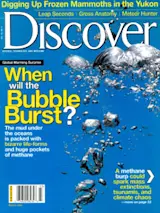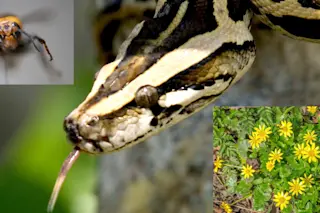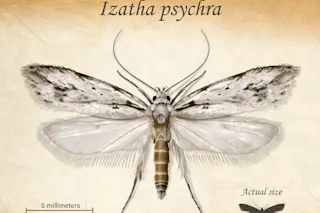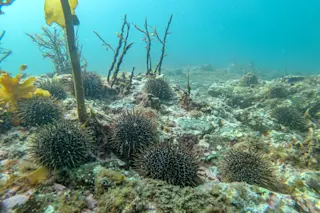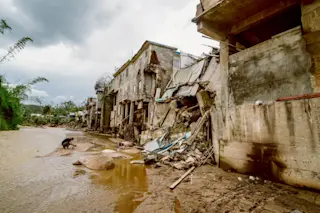Eight years ago, Richard Forman, a landscape ecologist at Harvard University, had what he describes as “a little epiphany.” Forman had gained renown with his book Land Mosaics: The Ecology of Landscapes and Regions and was subsequently invited to join a national council on the impact of the U.S. transportation network on ecology. The council focused largely on climate, but Forman realized that he and his colleagues were missing the point. “It occurred to me that the most conspicuous feature of the landscape was the least known”—roads.
This nation has 3.9 million miles of public roads and counting; cumulatively, those road surfaces cover 1 percent of the land—an area equivalent in size to South Carolina. Meanwhile, a growing body of research shows that roads have an ecological effect disproportionate to their size. They divert streams, change water tables, and abet the emission of carbon dioxide, ozone, and smog. They fill plants with heavy metals and kill lichens and mosses with their dust. Every road has its roadside: a bare, often harsh netherworld that invites the growth and spread of alien plants. On the whole, Forman estimates, the ecology of one-fifth of the United States is directly affected by roads.
Paved land for cars and trucks offers virtually every scientist something to dislike. So botanists, soil chemists, population biologists, and others have recently banded together to form a new interdisciplinary field: road ecology. In late 2002 Forman joined with Dan Sperling, a transportation expert at the University of California at Davis, to publish a survey of the field, Road Ecology, that sold out in five months. Sperling is now associate director of Davis’s new road ecology center. “The public has been raising Cain over the transportation community’s lack of sensitivity to environmental issues,” Forman says. Frustration equals lawsuits; lawsuits equal fewer new roads. It’s no surprise, therefore, that the center receives much of its funding from Caltrans, California’s embattled transportation authority.
In the early days, roads more or less obeyed the landscape, following rivers and forest edges. Now they’re often plunked down anywhere, carving up populations of wolves, bears, salamanders, and other animals that once roamed freely. Smaller populations fluctuate more widely in number than larger ones do and are more vulnerable to interbreeding. As a result, Forman says, roads are likely to cause local extinctions.
Roads also change the behavior of the animals that live near them. In the winter, caribou in Alaska migrate along cleared roads, making them vulnerable to trucks and wolves. Studies have found that black bears in North Carolina shift their home ranges away from busy road areas, as do grizzlies in the Rockies. Black vultures and turkey vultures, on the other hand, shift toward these areas, presumably for the ready supply of road carrion. One species of land snail actively avoids crossing roads, even narrow, unpaved ones. (Many snails aren’t just threatened by car tires but also the risk of drying up on the slow trek across hot pavement.) One remarkable study found that the heart rate of female bighorn sheep increased notably near a road, regardless of traffic.
Forman has spent weeks in the suburbs of Boston, mapping the road networks, gathering data on traffic volume, and, with local ornithologists, studying bird habitat. He hasn’t found many birds near roads. “For a quarter mile on either side of a suburban street, birds of conservation interest don’t reproduce,” he says. “You can envision these swaths around the highways of America with reduced populations.” His conclusion: “We’re wasting time spending money protecting land near busy highways, at least for birds.”
No ecological effect, however, is more direct, self-evident, or quantifiable than “road mortality.” In the United States, people kill more wildlife with their cars than they do any other way. Vehicles are the chief cause of death for moose in the Kenai National Wildlife Refuge in Alaska. Roads near Lake Jackson, Florida, are dangerous for turtles: More than 2,000 die per mile there each year. And 150 auto passengers are killed each year in animal collisions. “Clearly,” Forman says, “if I run into a moose, I’m in trouble.”
Road deaths affect whole species, particularly when large carnivores (which reproduce slowly) and small amphibians (which die en masse) are involved. In the 1980s and 1990s, 42 percent of all deaths of Florida panthers were caused by cars, and a recent study concluded that road mortality is so high that it may threaten the persistence of some turtle populations in the northeastern United States.
In the past decade, millions of dollars have been spent widening culverts and building “ecopassages” to permit animals to cross roads safely. (The nation’s first amphibian tunnel was built in Amherst, Massachusetts, in 1987 to aid the spring migration of the spotted salamander.) But for all the excitement surrounding these byways, few studies have shown how well they work or how they could be improved.
Anthony Clevenger, a wildlife biologist in Calgary, Alberta, set out to study a notorious 35-mile stretch of the Trans-Canada Highway known as The Meatmaker. The Meatmaker runs through the heart of Banff National Park, where cars kill hundreds of animals every year. Beginning in the 1980s, the park built a series of 24 culverts and two animal overpasses. To find out how effective they were, Clevenger and his team placed pits of dirt and soot at the ends of the byways to mark animal tracks. Every three days, the researchers returned to check the results. In seven years, Clevenger has tallied more than 40,000 wildlife crossings, including 22,000 elk, 1,000 cougars, and 750 black bears—altogether, the world’s largest database of ecopassage use.
Clevenger says different species react differently to the byways. Grizzlies, elk, and wolves prefer open overpasses and larger underpasses; black bears and cougars prefer more constricted underpasses. Snowshoe hares and red squirrels use culverts much less than do weasels and martens—perhaps because so many hungry weasels and martens are passing through: A dark alley makes a great shortcut until you get mugged in it.
Road ecology should be especially useful to countries like China and India, which are on what Sperling calls “a road-building frenzy.” To Europeans it’s mostly old news. For decades they have used ecopassages to help cram roads, people, and wildlife ever more tightly together. In the 1990s the Dutch rescued their badgers from the brink of threatened status by constructing 200 badger pipes. Barcelona recently embarked on an effort to integrate its urban sprawl with wildlife. The city’s chief planner? Richard Forman. “Europe, they’re way ahead of us,” he says, and sighs. “Our highway system has just gotten ahead of society.”


